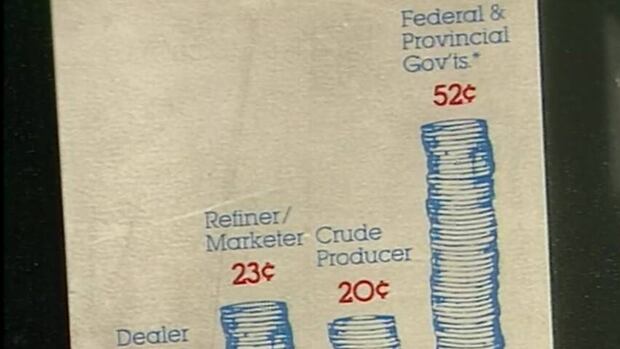What gas companies did when fuel cost too much in 1986
Esso stations posted a sticker on each pump to spell out where gas money went
Filling up the gas tank was getting to be a painful exercise, and the companies that sold it wanted drivers to know exactly where their gas dollar went in 1986.
A report by the CBC's Steve Paikin showed a gas pump with a sticker, apparently affixed by the dealer, that told them exactly that.
A graph depicted how each cent was allocated, per dollar spent on gasoline.
"Or, more specifically, the large bite governments are taking from the pockets of drivers," said Paikin.
'Out of sight'

The Ontario Motor League, a lobby group for drivers, had come out hard against the proportion of that gas dollar that went to taxes: 52 cents for federal and provincial governments, according to the sticker.
The league was asking the Ontario finance minister to knock off 1.1 cents per litre in taxes. At the time, gas cost 56 cents per litre, or about $1.29 per litre in 2022 dollars.

"The price of gas is just out of sight," said motor league spokesperson Alfred Oakie. "We have to bring that down, and that money pumped back into the economy will stimulate the economy pretty well."
According to the Globe and Mail, a study commissioned by the league found that the provincial government had taken in $211 million more in gas taxes in 1985 than it had spent on "road-related services."
But another group took a different view on drivers and gasoline.
Polluters should pay

"Energy Probe ... says society spends plenty more for hospitals and courts for drivers who make fatal mistakes," said Paikin.
"Cars pollute our air more than anything else," he added. "So high gas prices are needed to encourage conservation."
"If the OML is concerned about tourists wanting to come to come to Canada having to pay more gasoline," said Energy Probe's Kate Sutherland, "they should consider whether there will be lakes worth visiting if we don't deal with that problem."
Energy Probe cited a study that said the price of gas would have to go up by 10 to 15 cents per litre before drivers were paying their fair share of the costs of driving to the province.

